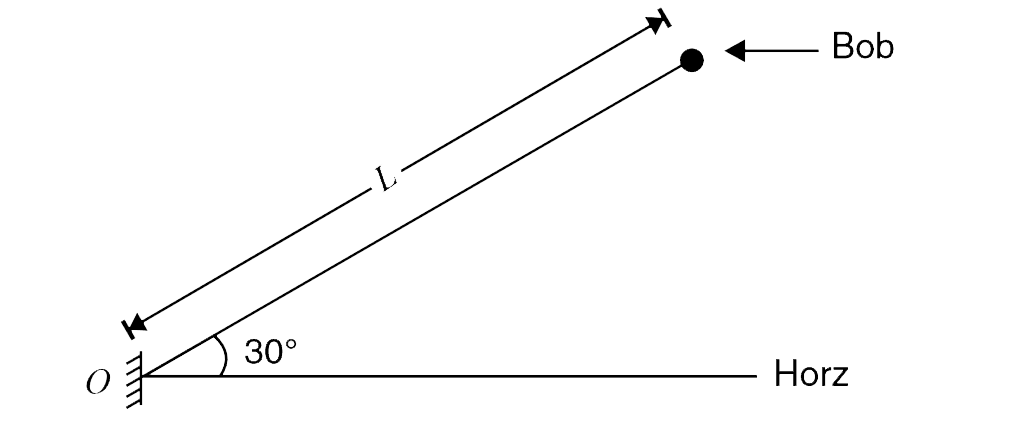A pendulum of mass 1 kg and length = 1m is released from rest at angle = 60º. The power delivered by all the forces acting on the bob at angle = 30º will be: (g = 10 m/s2)
13.4W
20.4W
24.6W
zero
The correct Answer is:A
To solve the problem, we will follow these steps:
Step 1: Understand the problem
We have a pendulum bob of mass m=1kg and length ℓ=1m released from an angle of θ=60∘. We need to find the power delivered by all forces acting on the bob when it reaches an angle of θ=30∘.
Step 2: Identify the forces acting on the bob
The forces acting on the bob are:
1. Gravitational force (→Fg=m→g)
2. Tension in the string (→T)
Step 3: Calculate the gravitational force components
At θ=30∘:
- The component of the gravitational force acting along the direction of motion (tangential) is given by:
Ftangential=mgsin(30∘)=1×10×12=5N
Step 4: Determine the velocity of the bob at θ=30∘
Using conservation of mechanical energy:
- Initial potential energy at θ=60∘:
h1=ℓ(1−cos(60∘))=1×(1−0.5)=0.5m
PE1=mgh1=1×10×0.5=5J
- Final potential energy at θ=30∘:
h2=ℓ(1−cos(30∘))=1×(1−√32)=1−0.866=0.134m
PE2=mgh2=1×10×0.134=1.34J
- Kinetic energy at θ=30∘:
KE=PE1−PE2=5−1.34=3.66J
Using the kinetic energy formula:
KE=12mv2⟹3.66=12×1×v2⟹v2=7.32⟹v=√7.32≈2.71m/s
Step 5: Calculate the power delivered by the forces
The power delivered by the tangential component of the gravitational force is:
P=Ftangential⋅v=5×2.71≈13.55W
Final Answer
The power delivered by all the forces acting on the bob at angle θ=30∘ is approximately 13.55W.
---
We have a pendulum bob of mass m=1kg and length ℓ=1m released from an angle of θ=60∘. We need to find the power delivered by all forces acting on the bob when it reaches an angle of θ=30∘.
The forces acting on the bob are:
1. Gravitational force (→Fg=m→g)
2. Tension in the string (→T)
At θ=30∘:
- The component of the gravitational force acting along the direction of motion (tangential) is given by:
Ftangential=mgsin(30∘)=1×10×12=5N
Using conservation of mechanical energy:
- Initial potential energy at θ=60∘:
h1=ℓ(1−cos(60∘))=1×(1−0.5)=0.5m
PE1=mgh1=1×10×0.5=5J
h2=ℓ(1−cos(30∘))=1×(1−√32)=1−0.866=0.134m
PE2=mgh2=1×10×0.134=1.34J
KE=PE1−PE2=5−1.34=3.66J
Using the kinetic energy formula:
KE=12mv2⟹3.66=12×1×v2⟹v2=7.32⟹v=√7.32≈2.71m/s
The power delivered by the tangential component of the gravitational force is:
P=Ftangential⋅v=5×2.71≈13.55W
The power delivered by all the forces acting on the bob at angle θ=30∘ is approximately 13.55W.
Topper's Solved these Questions
Similar Questions
A pendulum bob of mass m and length L is released from angle θ with the vertical. Find
(a) the speed of the bob at the bottom of the swing and
(b) tension in the string at that time
View SolutionA pendulum has length L = 1.8 m. The bob is released from position shown in the figure. Find the tension in the string when the bob reaches the lowest position. Mass of the bob is 1 kg.

View Solution
Knowledge Check
A pendulum of length = 1 m is released from 0 = 60º. The rate of change of speed of the bob at = 30º is: (g = 10 m/s2)
 A5√3m/s2B5m/s2C10m/s2D2.5m/s2
A5√3m/s2B5m/s2C10m/s2D2.5m/s2A pendulum of length l=1m is released from θ0=60∘ . The rate of change of speed of the bob at θ=30∘ is.
 A5√3m/s2B5m/s2C10m/s2D2.5m/s2
A5√3m/s2B5m/s2C10m/s2D2.5m/s2A pendulum of length l = 1m is released from θ0=60∘. The rate of change of speed of the bob at θ=30∘ is (g=10m/s2)
A5√3m/s2B5m/s2C10m/s2D2.5m/s2
A particle of mass 1 kg is projected at an angle of 30∘ with horizontal with velocity v = 40 m/s . The change in linear momentum of the particle after time t = 1 s will be (g = 10 m/s2)
View SolutionWhat is the gravitaional force acting on 2 kg mass ? [Take g = 10ms^(-2)]
View SolutionThe bob of a pendulum of length 980 cm is released from rest with its string making an angle 60∘ with the vertical. It collides with a ball of mass 20 gm resting on a smooth horizontal surface just at the position of rest of the pendulum. With what velocity will the bob move immediately after the collision? What will be the maximum angular displacement of the bob after them collision ? The mass of the bob is 10 gm. '
View SolutionA uniform rope of mass M=0.1kg and length L=10m hangs from the celling. [g=10m/s2] :-
View SolutionA body of mass m kg starts from rest and travels a distance of s m in t seconds. The force acting on it is
View Solution

